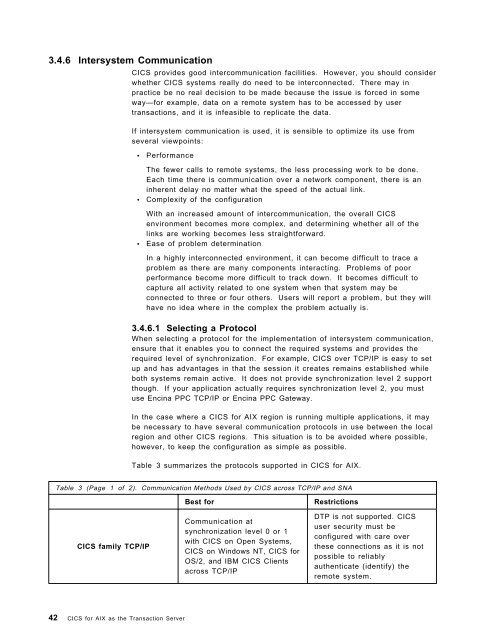Addressing OLTP Solutions with CICS: The Transaction Server ... - Ibm
Addressing OLTP Solutions with CICS: The Transaction Server ... - Ibm
Addressing OLTP Solutions with CICS: The Transaction Server ... - Ibm
Create successful ePaper yourself
Turn your PDF publications into a flip-book with our unique Google optimized e-Paper software.
3.4.6 Intersystem Communication<br />
<strong>CICS</strong> provides good intercommunication facilities. However, you should consider<br />
whether <strong>CICS</strong> systems really do need to be interconnected. <strong>The</strong>re may in<br />
practice be no real decision to be made because the issue is forced in some<br />
way—for example, data on a remote system has to be accessed by user<br />
transactions, and it is infeasible to replicate the data.<br />
If intersystem communication is used, it is sensible to optimize its use from<br />
several viewpoints:<br />
• Performance<br />
<strong>The</strong> fewer calls to remote systems, the less processing work to be done.<br />
Each time there is communication over a network component, there is an<br />
inherent delay no matter what the speed of the actual link.<br />
• Complexity of the configuration<br />
With an increased amount of intercommunication, the overall <strong>CICS</strong><br />
environment becomes more complex, and determining whether all of the<br />
links are working becomes less straightforward.<br />
• Ease of problem determination<br />
In a highly interconnected environment, it can become difficult to trace a<br />
problem as there are many components interacting. Problems of poor<br />
performance become more difficult to track down. It becomes difficult to<br />
capture all activity related to one system when that system may be<br />
connected to three or four others. Users will report a problem, but they will<br />
have no idea where in the complex the problem actually is.<br />
3.4.6.1 Selecting a Protocol<br />
When selecting a protocol for the implementation of intersystem communication,<br />
ensure that it enables you to connect the required systems and provides the<br />
required level of synchronization. For example, <strong>CICS</strong> over TCP/IP is easy to set<br />
up and has advantages in that the session it creates remains established while<br />
both systems remain active. It does not provide synchronization level 2 support<br />
though. If your application actually requires synchronization level 2, you must<br />
use Encina PPC TCP/IP or Encina PPC Gateway.<br />
In the case where a <strong>CICS</strong> for AIX region is running multiple applications, it may<br />
be necessary to have several communication protocols in use between the local<br />
region and other <strong>CICS</strong> regions. This situation is to be avoided where possible,<br />
however, to keep the configuration as simple as possible.<br />
Table 3 summarizes the protocols supported in <strong>CICS</strong> for AIX.<br />
Table 3 (Page 1 of 2). Communication Methods Used by <strong>CICS</strong> across TCP/IP and SNA<br />
<strong>CICS</strong> family TCP/IP<br />
42 <strong>CICS</strong> for AIX as the <strong>Transaction</strong> <strong>Server</strong><br />
Best for Restrictions<br />
Communication at<br />
synchronization level 0 or 1<br />
<strong>with</strong> <strong>CICS</strong> on Open Systems,<br />
<strong>CICS</strong> on Windows NT, <strong>CICS</strong> for<br />
OS/2, and IBM <strong>CICS</strong> Clients<br />
across TCP/IP<br />
DTP is not supported. <strong>CICS</strong><br />
user security must be<br />
configured <strong>with</strong> care over<br />
these connections as it is not<br />
possible to reliably<br />
authenticate (identify) the<br />
remote system.
















